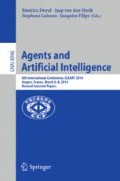Abstract
Traditional user interface design works best for applications that only have a relatively small number of operations for the user to choose from. These applications achieve usability by maintaining a simple correspondence between user goals and interface elements such as menu items or icons. But we are entering an era of high-functionality applications, where there may be hundreds or thousands of possible operations. In contexts like mobile phones, even if each individual application is simple, the combined functionality represented by the entire phone constitutes such a high-functionality command set. How are we going to manage the continued growth of high-functionality computing? Artificial Intelligence promises some strategies for dealing with high-functionality situations. Interfaces can be oriented around the goals of the user rather than the features of the hardware or software. New interaction modalities like natural language, speech, gesture, vision, and multi-modal interfaces can extend the interface vocabulary. End-user programming can rethink the computer as a collection of capabilities to be composed on the fly rather than a set of predefined “applications”. We also need new ways of teaching users about what kind of capabilities are available to them, and how to interact in high-functionality situations.
Access this chapter
Tax calculation will be finalised at checkout
Purchases are for personal use only
References
Faaborg, A., Lieberman, H.: A goal-oriented web browser. In: Cypher, A., Dontcheva, M., Lau, T., Nichols, J. (eds.) No Code Required: End-User Programming for the Web. Morgan Kaufmann (2010)
Fry, C., Lieberman, H.: Decision-making should be more like programming. In: International Symposium on End-User Development, Copenhagen, June 2013
Kelleher, C., Pausch, R.: Stencil based tutorials: design and evaluation. In: CHI 2005, pp. 541–550
Lieberman, H. (ed.) Your Wish is My Command: Programming by Example. Morgan Kaufmann (2001)
Lieberman, H., Liu, H., Singh, P., Barry, B.: Beating common sense into interactive applications. AI Magazine, Association for the Advancement of Artificial Intelligence, Winter 2004–2005
Lieberman, H., Paterno, F., Wulf, V. (eds.) End-User Development, Springer (2006)
Lieberman, H., Esp, J.: A goal-oriented interface to consumer electronics using planning and commonsense reasoning. Knowl.-Based Syst. J. 20, 592–606 (2007)
Lieberman, H.: Say Hello to Smarter Apps That Fulfill Your Wishes, Wired, UK, p. 70, November 2012
Lieberman, H., Rosenzweig, E., Fry, C.: Steptorials: Mixed-initiative learning of high functionality applications. In: ACM Conference on Intelligent User Interfaces (IUI-14), Haifa, Israel, February 2014
Liu, H., Lieberman, H.: Metafor: visualizing stories as code. In: ACM Conference on Intelligent User Interfaces (IUI-2005), San Diego, January 2005
Norman, D.A.: Affordance, conventions and design. Interactions 6(3), 38–43 (1999). ACM Press
Author information
Authors and Affiliations
Corresponding author
Editor information
Editors and Affiliations
Rights and permissions
Copyright information
© 2015 Springer International Publishing Switzerland
About this paper
Cite this paper
Lieberman, H., Fry, C., Rosenzweig, E. (2015). The New Era of High-Functionality Interfaces. In: Duval, B., van den Herik, J., Loiseau, S., Filipe, J. (eds) Agents and Artificial Intelligence. ICAART 2014. Lecture Notes in Computer Science(), vol 8946. Springer, Cham. https://doi.org/10.1007/978-3-319-25210-0_1
Download citation
DOI: https://doi.org/10.1007/978-3-319-25210-0_1
Published:
Publisher Name: Springer, Cham
Print ISBN: 978-3-319-25209-4
Online ISBN: 978-3-319-25210-0
eBook Packages: Computer ScienceComputer Science (R0)

